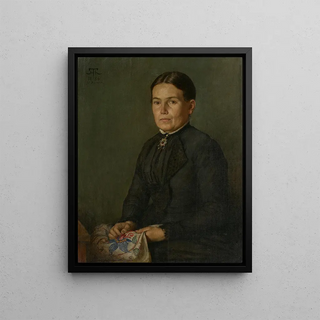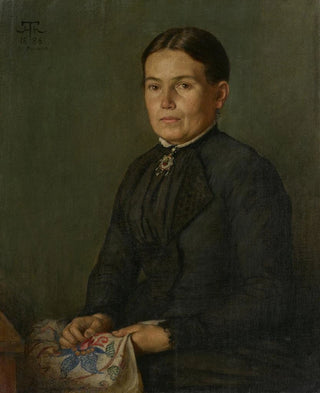Art print | Portrait of the artist Sister Agathe - Hans Thoma


View from behind

Frame (optional)
Art print Portrait of the artist Sister Agathe - Hans Thoma – Captivating introduction
In the vast panorama of art history, certain works stand out for their ability to capture the very essence of their subject. The "Portrait of the artist Sister Agathe" by Hans Thoma is one of these remarkable pieces. Created at the end of the 19th century, this work embodies not only Thoma's exceptional talent but also an era where art aimed to reflect emotions and inner thoughts. The depiction of Sister Agathe, a religious figure imbued with serenity and wisdom, invites the viewer to a deep contemplation, at the crossroads between spirituality and art. This portrait, both intimate and universal, evokes an atmosphere of peace that still resonates today.
Style and uniqueness of the work
Hans Thoma's style is characterized by a subtle harmony between realism and idealization. In the "Portrait of the artist Sister Agathe," Thoma manages to capture not only the physical features of his model but also her soul. The chosen color palette, soft and soothing, contributes to the serene atmosphere of the work. The delicately crafted play of light highlights the expressions on Sister Agathe's face, revealing an emotional depth that transcends a simple portrait. The details, whether in her dress fabric or in the gentleness of her gaze, testify to a meticulous attention to detail that is Thoma's signature. This portrait, far from being a mere representation, becomes a true window into Sister Agathe's personality, inviting the viewer to question her story and life.
The artist and his influence
Hans Thoma, born in 1839, is one of the most emblematic artists of the German artistic movement of the late 19th century. Influenced by realism and romanticism, he managed to create a style that is uniquely his own, blending tradition and innovation. His work is marked by profound humanity, and he always sought to depict the world with a unique sensitivity. Thoma also played a crucial role in the rediscovery of German folk art, incorporating folkloric elements into his creations. His commitment to spirituality

Matte finish

View from behind

Frame (optional)
Art print Portrait of the artist Sister Agathe - Hans Thoma – Captivating introduction
In the vast panorama of art history, certain works stand out for their ability to capture the very essence of their subject. The "Portrait of the artist Sister Agathe" by Hans Thoma is one of these remarkable pieces. Created at the end of the 19th century, this work embodies not only Thoma's exceptional talent but also an era where art aimed to reflect emotions and inner thoughts. The depiction of Sister Agathe, a religious figure imbued with serenity and wisdom, invites the viewer to a deep contemplation, at the crossroads between spirituality and art. This portrait, both intimate and universal, evokes an atmosphere of peace that still resonates today.
Style and uniqueness of the work
Hans Thoma's style is characterized by a subtle harmony between realism and idealization. In the "Portrait of the artist Sister Agathe," Thoma manages to capture not only the physical features of his model but also her soul. The chosen color palette, soft and soothing, contributes to the serene atmosphere of the work. The delicately crafted play of light highlights the expressions on Sister Agathe's face, revealing an emotional depth that transcends a simple portrait. The details, whether in her dress fabric or in the gentleness of her gaze, testify to a meticulous attention to detail that is Thoma's signature. This portrait, far from being a mere representation, becomes a true window into Sister Agathe's personality, inviting the viewer to question her story and life.
The artist and his influence
Hans Thoma, born in 1839, is one of the most emblematic artists of the German artistic movement of the late 19th century. Influenced by realism and romanticism, he managed to create a style that is uniquely his own, blending tradition and innovation. His work is marked by profound humanity, and he always sought to depict the world with a unique sensitivity. Thoma also played a crucial role in the rediscovery of German folk art, incorporating folkloric elements into his creations. His commitment to spirituality






